Which pen should I use?
In conservation there are a number of media that you'll need to write on, from boxes, folders and labels to photograph sleeves and metal. Selecting the correct pen for the job is important to ensure that the ink is suitable for the application, the last thing you would want is permanent ink transferring through to, or rubbing off on an object, onto your hands or gloves, or your clothes!
We keep a number of black permanent pens which are widely used in conservation settings, but how do these pens perform under various conditions they may be used?
For this test we're looking at the following pens: 
We're testing all of the pens by using them on; standard notepad paper, polyester film, Tyvek non-woven material, and coated archival box board. Additionally we will be looking at the inks' water resistance, and resistance to alcohol (in this case alcohol hand gel). Alcohol is often used in conservation and alcohol based hand sanitisers are likely to become as much part of office consumables as pens and pencils, so it may be important in some instances for a pen's ink to be stable when alcohol based gels are applied as a solvent.
> | Explore all pens and writing tools here
Pen Test 1 - Using the pens on paper
Some of these pens aren't designed to be used on paper, but for completeness we've tested them on all media.
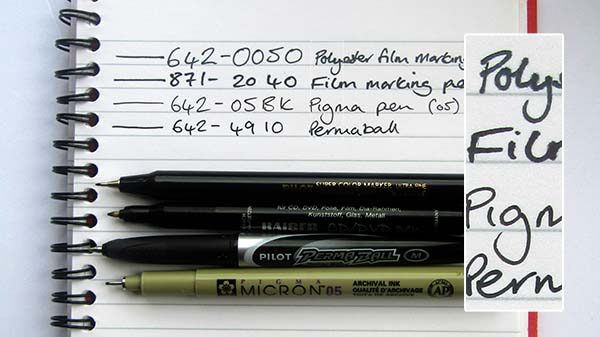
As expected the two pens designed for writing on non-porous surfaces don't perform well on paper, although usable, they do bleed - the Kaiser film marking pen is the better performer of the two with a darker black and less spread. The Pigma Micron fibre tipped pens and (unfortunately now discontinued) Permaball roller pens are far easier to write with and don't bleed into the page. The Permaball is the nicest to write with, very little resistance and a crisp edge to the text.

Looking at the other side of the sheet really reveals why the Pigma Micron pens and Permaball Roller Ball pens are best for working on paper with little or no bleed through the sheet. The other two pens saturated the sheet and marked the one beneath.
Pen Test 2 - Writing on box board and washing with water
Our grey archival box board has a smooth moisture resistant top ply (top surface sizing: Cobb60 in accordance with ISO 535 < 25). It allows the boxes to be cleaned and resists soiling.

All of the pens seem suitable for this job, due to the sizing, the pens designed for non-porous surfaces work OK and don't bleed. But what happens when we wash with water, I gave the box a good scrub with a soaking wet cloth and tap water.
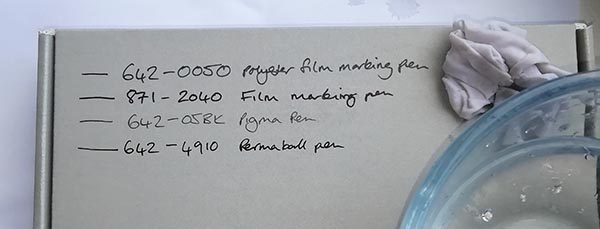
Shown above, all inks were stable under a good soaking and pretty robust scrub. In terms of contrast, the 871-2040 Kaiser Film marking pen, and the 642-4910 Permaball pens offered the best blacks.
Pen Test 3 - Writing on Tyvek and saturating in water (See test 4 for alcohol)
Tyvek is an inert and acid free non-woven material used for a number of conservation purposes. The polyester non-woven fabric provides a waterproof and mould free material ideal for protection and storage. We also sell Tyvek tags which can be used for identification archival purposes, and these obviously need to be written on with something . But how do our pens perform when being used on Tyvek, which feels like paper, but is actually randomly spun bound polyester?
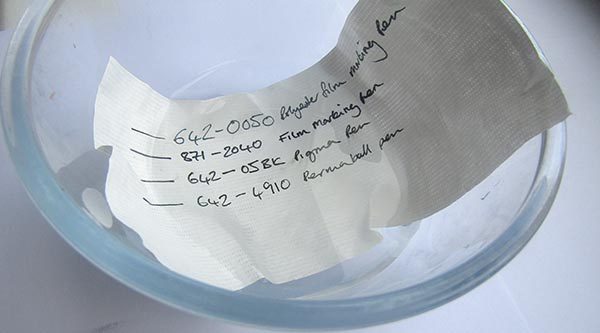
All of the pens wrote on the Tyvek as though it were paper, in-fact with less bleeding than was present on the notepad. After giving the inks 2 minutes to dry, the sheet was submerged in a bowl of water and left for 15 minutes. On removal from the water the inks appear generally unaffected.

I took a clean cotton cloth and wiped the surface of the Tyvek to remove any water and to test the stability of the inks.

The Pigma Micron ink was not as resistant to the water and wiping as the other pens and lost the ink from the top surface of the Tyvek. This is likely down to the Pigma Micron ink being pigment based and not dye based, the pigment stays on the surface and doesn't leach into the Tyvek as the dye pens do. The other three pen's inks were completely stable and did not show any changes as a result of the water or wiping.
Pen Test 4 - Writing on Tyvek and saturating in alcohol (hand sanitiser)
Alcohol is used in a number of conservation applications, and will be present in most homes and workplaces in the form of hand sanitiser. But how stable are our pens inks when saturated with alcohol hand sanitiser gel? I prepared a new section of Tyvek with the same pens and text, allowed the inks to dry and then submerged in alcohol based hand sanitiser.
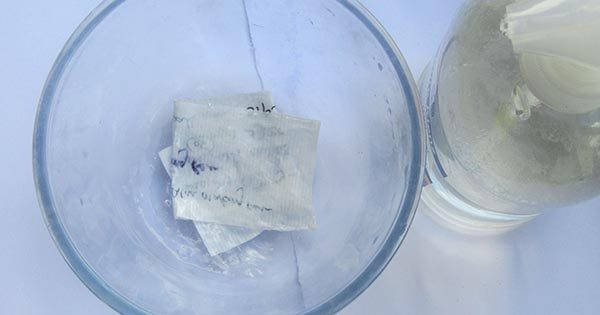
After leaving the Tyvek submerged for 30 minutes, the test strip of Tyvek was removed to see what had happened to the inks.
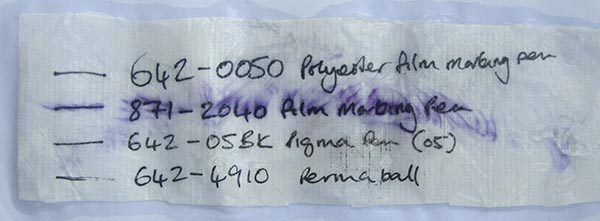
And then wiped away the residual hand sanitiser...

The 642-0050 Polyester film marking pen and the 642-4910 Permaball pen were completely unaffected by the hand gel in this test. The Pigma Micron Pen showed similar results to the water saturation test, it didn't necessarily run, but just perhaps isn't stable on Tyvek as a surface. The 871-2040 Kaiser film marking pen was solvent in the alcohol gel, it made a bit of a mess.
Pen test 5 - Writing on clear film (polyester)
A pen that is capable of writing on and staying on a non-porous surface, such as polyester, will be useful for any number of jobs (as well as writing on polyester). It's going to be important that the ink will dry on the surface to prevent it being transferred when touched. Hands up those who remember 'Overhead Projector Pens'!

All of the pens were capable of writing on the polyester, the film marking pens and pigma pen being the easiest. The Permaball being a roller ball pen wasn't great on this surface, the ball would stick and wasn't as fluid as on paper or card.
To test the stability of the pen's ink on the surface, having allowed time to dry, I rubbed it with a clean damp cotton cloth.
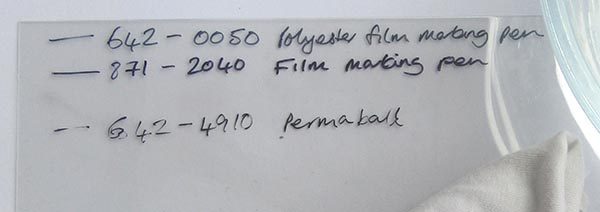
The Pigma Micron pen ink was totally removed after the surface had been wiped, the other pen inks were stable. I then gave them a wipe with the alcohol hand gel to see if they would rinse from the surface.

The Polyester Film Marking pen, 642-0050 really is 'permanent'!
So what pen should you use?
The Acid-Free Pen - One of the issues that we haven't touched upon is that the Pigma Micron pens are acid-free and therefore can be used in an archival storage environment, sometimes if required, directly on objects. Read more about the Pigma Micron pens on their page here. So if the writing is on a tag, label, folder or a box that will be stored in an enclosure, the Pigma Micron pens are the best solution. The manufacturer shows a case study where they are being used to mark identification onto bone here.
The best multi-purpose pen - The Permaball pen is a pleasure to write with on paper and board, it's by far the best 'writing' pen. It also performed well on Tyvek and is waterproof and alcohol (hand sanitiser) proof. The black ink is a rich black and possibly the best of these four pens. The manufacturer states that they are also suitable for writing on ceramics and metal, which although not shown here they definitely can, but being a rollerball can hinder them slightly unless the surface is textured.
The most resilient pen - Of the two film marking pens, the 642-0050 Pilot Super Color pen is the most resilient and 'permanent' pen. Being waterproof and alcohol (hand sanitiser) proof could be valuable in conservation. However, the 871-2040 Kaiser film marking pen is a darker black and possibly easier to remove should it be required.
A case can be made for all of these pens dependent upon the media on which they are to be used, and expected exposure to water or alcohol.
> | Explore all pens and writing tools here